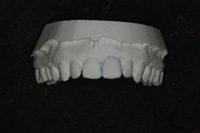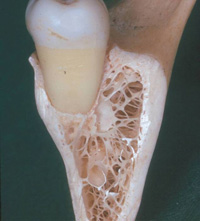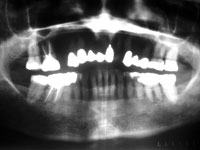How would a businessman handle the overhead expenses in a dental office? Would he make decisions the same way a dentist would? Our training in dental school was not from a business perspective, but rather from a scientific/analytical/statistical approach. The latter approach can be applied to business decisions, but with an added ingredient. Some call this added ingredient “schrewdness” or “wisdom” because different decisions should be made depending on different circumstances. Too often we look for a cookbook formula that leads us to the wrong answer.
From a credibility standpoint, I have a solo practice in the top 1% of practices, with an overhead much less than 50%. Having said that, I have purposely let the overhead rise at times because it was a smart decision for the long run. (The practice I took over from near bankruptcy 7 years ago had an overhead of almost 100%). The point is, overhead can and should be all over the spectrum as long as it is aligned with your business strategy.
What is the big mystery with overhead? Why is it that some offices are at 40% while others are over 100%? The obvious goal of every office is to reduce the overhead, which requires 2 things: (1) smart and prudent business strategy, and (2) constant monitoring and effort. Both are equally important. With a great game plan that is not implemented or monitored, you would not bring down the overhead. Monitoring without making smart business decisions may be successful in the short run, but you will not reach your potential.
In order to understand overhead and then make smart decisions, you have to simplify and analyze from the basics: net income equals gross income minus expenses.
The name of the game is obviously to increase net income, which really boils down to 2 ways of doing it; either reduce your expenses or increase your gross income. If every decision is made with the following question as a guidepost, you simplify the process of finding the answer. The question is, Is whatever I’m doing, or whatever decision I’m making, going to help make me money (increase gross) or save me money (reduce costs)? For those who are impressed with catchy buzzwords, these are called return on investment and cost analysis.
Practice expenses are broken down into 2 categories—fixed and variable. The fixed costs are items such as rent, which once negotiated, stay relatively fixed from month to month. Smart business principles should dictate what you should be paying. It does not make sense to be in an industrial part of town with difficult access for your patients simply because you will save rent. Your overhead will be down from strictly a numbers point of view in your financial statement, but your gross income won’t be as high since you will not attract as many patients because of a less-than-desirable location. The end result is lower net income. Patients with busy lives are forever looking for convenience. Why make it difficult for your patients to give you money? There are exceptions to this, however, and we do need to avoid the cookbook mentality of looking for a correct answer for all dentists. If I had exceptional talent that was known around the globe and people specifically sought me out, I would practice where I could find cheap rent. If I was a specialist with a strong base of referrals, I would look for the cheapest rent.
Another factor to consider is the image of the location. You say different things to the patients’ psyche if you are on the top floor of an office tower versus the mall or in the trendy district of town versus its run-down section. It’s image and marketing. Depending on your business strategy, you could do well in each of those locations. The point is, the decision to pay rent involves more than a bottom line figure, but rather a thought process to make wise decisions that are correct for your strategy.
Looking at the variable expense side, the ability to negotiate is required, which in itself is a skill and a game that the dentist or staff need to develop. The rest of the world is comfortable with negotiating, and use it as a normal part of doing business. In North America, most reserve this process for big- ticket items such as a car or a house. However, you’d be amazed at which items can be negotiated if you are open to the concept.
Variable costs go up the busier you get. The solution to this is to negotiate better deals because of volume. This is a nice problem to have, similar to dentists who complain about how much taxes they are paying. But they are paying more taxes because they made more money. Would you rather make no money and be ecstatic because you’re not paying any taxes? If you don’t have a large volume, assess your needs for the year and negotiate once. But you must monitor your cash flow situation. In most situations, it doesn’t make sense to save on a deal, then pay interest or lease payments. Interestingly, the millionaires studied in the best-selling book, The Millionaire Next Door, pay cash and do not believe in carrying debt.
Admittedly, you get to a certain point when your expenses cannot go down any further without shooting yourself in the leg. Despite the importance of negotiating the best possible prices for your purchases, it must be recognized that dentists with high overhead are not paying significantly more for items such as supplies than those with low overhead. I may get Product X slightly cheaper, which cumulatively for a large number of products can add up to a nice savings. However, to make a significant difference in overhead, the answer lies in a different approach, which is to increase gross income and resultant net income. In our profession, the practices that are in the top 1% generally tend to focus on increasing the gross income side of the equation.
If you look at the total dollar value of the expenses of the successful practices, it is much higher than less successful practices, but the gross income is also significantly higher, and the resultant net income is also higher. If you produce significantly more, you still will be paying the same fixed costs such as rent and property taxes, yet you will have much more money left over, even taking the variable expenses into consideration.
The problem with comparing overheads is that people look at it from a percentage perspective. Most of the expenses vary only a few percentage points from one practice to another. When your gross income goes up, the expense portion relatively decreases, which gives a dentist bragging rights when you look at it from a percentage perspective.
THE CARDINAL QUESTION
If you make decisions based on an overall strategy or a game plan, the numbers do take care of themselves. Sometimes you have to spend money to make money, but this involves a thought process, not a haphazard spending spree. One other caution that also applies to our personal lives is this: the distinction between need and want often gets blurred. It is at this point you have to go back to the cardinal question posed at the beginning of this article, which is, Is what I’m buying going to make me money or save me some costs? If the answer is no, then you don’t buy. Following this simple-but-effective rule is a major factor in controlling overhead.
Dr. Hussein is a full-time practicing dentist who understands what it takes to be successful in the trenches with a bread-and-butter practice. He is an author/lecturer on the numerous aspects of running a practice in the real world. To contact him, or to receive information on the secrets of the top 1% practices, call Pinnacle Practice Performance at (866) 823-1230.











